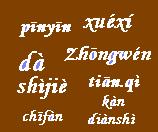This web site helps Mandarin speakers, native, semi-native, or non-native, learn Hanyu Pinyin, a Mandarin phonetic transcription system using a modified Latin alphabet. Given that these learners already speak Mandarin, exemplification is prioritized over explanation.

Advice on Learning Approach
About Exercises in This Site
About Characters in This Site
The Computer and the Browser
-
Hanyu Pinyin (º~»y«÷µ), often abbreviated as Pinyin («÷µ; "spelling sounds" literally), is the most widely used Mandarin romanization system: P. R. China and Singapore, and many other countries as well. The Library of Congress uses Pinyin to catalog its collection in Chinese, most contemporary dictionaries use Pinyin to spell out Chinese characters, and the vast majority of Chinese textbooks published overseas use Pinyin, to name just a few. (Learn more about different systems of Mandarin phonetic transcription at Omniglot.)
-
Hanyu Pinyin is a simple and efficient tool for Chinese word processing. You can download Office XP Tool: Global IME (Input Method Editor), Golbal IME 5.02 for Windows 95, 98, and NT 4.0, or a demo version of NJStar Chinese Word Processor 4.35.
Just like "cultural" is pronounced differently in French and English, "can" symbolizes different sounds in Mandarin and English -- the sounds represented by a certain letter are not always the same in different languages. Therefore, when learning Pinyin, instead of referring to the English pronunciation of each letter, you should try to establish a direct connection between a certain letter, or sequence of letters (like "sh", "ang", etc.) and the exact Mandarin sound represented. In other words, using Chinese characters as reminders of sounds represented by Pinyin letters will be much more sensible since you already know the Mandarin sounds.
-
Exercises will open in a new
window so that you can check the relevant information when necessary.
Complex characters are used because most people who use simplified characters know Hanyu Pinyin.
For best results, use a PC, and upgrade to Internet Explorer 6 for PC or Netscape 7.01. The encoding of your browser should be "Western European (ISO)" or "Traditional Chinese (Big5)", although the latter disallows some browsers to show Pinyin letters with tone marks. The animations work well with Internet Explore 5, but not earlier versions of Netscape. And some pages may take a while to load.